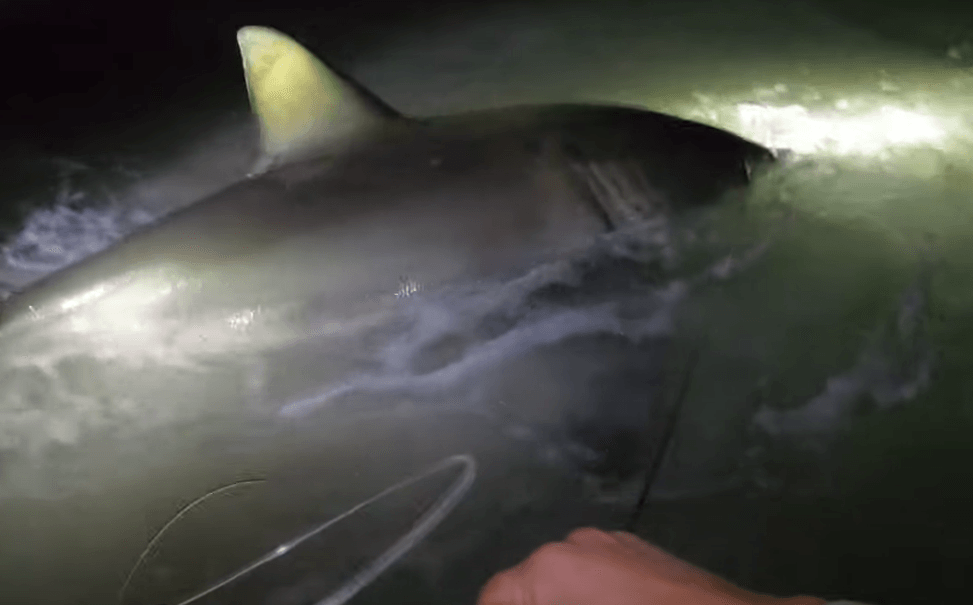Great White Shark caught from the shore on Pensacola Beach
Big John Shark Fishing Adventures catches great white shark from Pensacola Beach (video below).

(OBA®) – A Mississippi State University shark researcher has confirmed that a shark caught off the beach in Pensacola is a great white shark.
A fisherman from Idaho apparently caught the great white shark earlier this week fishing off the beach with Big John’s Shark Fishing Adventures.
“You just caught a great white,” Big John McLean tells the fisherman in a YouTube video. “This is the rarest thing ever. Dude that is something you will never see.”
Dr. Marcus Drymon of the Mississippi State Coastal Extension and Research Center watched the a six-minute video of the catch and release and said he was sure the fish was a great white. (See video below.)
“I could see enough to tell it was a white shark for sure,” Drymon said. “It is rare to catch one from the beach, that’s a fact. It’s not particularly rare that they are in the area. It’s cool but it’s not rare.”
Big John said it was a thrill for him and the visitors from Idaho to see a great white on Pensacola Beach.
“As far as my knowledge that was the first one that was caught on Pensacola Beach,” Big John said. “We’re obviously not targeting great whites and I never thought I’d never seen one here on the panhandle. When I saw it, I just knew the biggest thing was we had to get it back and get it in the water. I never thought I’d ever see one and knew just based on that and how clean the release was and the video with it that’s why I chose to post it. I think it’s a unique, once in a lifetime kind of fish.”
For Drymon, the actions of the fishermen and Big John were impressive as was their knowledge of how to handle such a catch.
“I’ll say the anglers did a good job of getting the fish released as quickly as possible and you could tell they had the fish’s best interest in mind,” Drymon said. “They should be commended for that for sure.”
By law, great whites are for catch and release only but Drymon thought this group went above and beyond and seemed to genuinely enjoy and appreciate the experience.
“They are protected,” Drymon said. “In my mind, it was pretty clear that the anglers knew that and I would say to me that was the most interesting thing about a situation like this. Rather than being terrified they caught a great white they struck me as being really excited to actually be able to see a creature like that which is pretty cool.”
Using Bonita for bait, Big John said the hook placement was perfect, just in the jaw on the left side of the fish’s mouth. One measure he didn’t follow was part of releasing the great white but he did so out of concern for the shark.
“I was able to remove it with a two-foot steel de hooker which works really nice,” he said. “The rules when you get a great white you are supposed to cut the wire. I don’t ever like to leave a hook in a shark’s mouth so I was able to get that out really quick and there was no blood. That was my main priority at the time.”
Just because sharks seem to be appearing more frequently doesn’t mean there are more out there, Drymon said. Improved techniques to catch the big fish, even from the beach, are the main factor.
“I saw all the gear,” he said. “These guys have gotten very good at targeting big sharks like that so it’s not so much there’s more of those white sharks in the area it’s that these fishermen are getting better at getting bait out past the surf zone, using heavy tackle and things like that.”
Big John said the great white initially didn’t make a run like most of the sharks he’s caught or seen caught in the past and the fight was only about 35 minutes.
“Sometimes sharks will run out 200 yards of line before you start getting line back,” Big John said. “This one didn’t act like anything I’d ever seen before. The shark didn’t realize he was hooked until he hit the second sandbar. As soon as he saw that second sandbar, he took off a couple of times. At that time, I still didn’t know it was a great white. I caught a 12-foot-6-inch dusky back in January and it fought like that. When I saw that fin, I knew immediately what it was. I think we all were kind of in shock.”
Rules surrounding catch and release of great whites don’t permit measuring of them when they are hooked but Big John based his size estimate on past experience and knowledge of what certain sharks weigh at certain lengths.
“I’ve caught several 12-foot sharks over the past couple of years and just by looking at it I know it was for sure 12-foot and actually it could have been up to 13 feet but I didn’t have an actual measure on the shark,” he said. “It was a female and just looking at stats of female white sharks of 12 feet the majority of them are 1,200 pounds so I’m sure it was 1,200 pounds. I’ve caught 12-foot tiger sharks and most of those are going to be around 900 to 1,000 pounds but those are different fish.”
According to Big John’s website, he has five years of shark fishing experience and loves the uncertainty of what’ll be on the end of the line when a big fish strikes.
“The cool part about it is you have no idea anytime what you’re going to catch and that’s what’s so exciting to me and the clients as well,” he said.
The OCEARCH group recently reported two great white sharks it is tracking were 20 to 40 miles off shore in the areas of Orange Beach, Gulf Shores, Fort Morgan and Dauphin Island but did not consider them “dangerously close.” The research organization tracks shark movements in the world’s oceans and three of their tagged fish are currently in the northern Gulf of Mexico area off Alabama’s coast. The third is a tiger shark, the group reported.
“That boat just puts out tags on the fish they catch but honestly, they don’t do a lot of tagging in the Gulf,” Drymon said. “They do a lot of their tagging in South Carolina and they are in North Carolina as we speak. As the sharks come around the coast of Florida and get into the Gulf, they start pinging like that which is how the tags work.”
According to their website, “OCEARCH has carefully crafted its procedures to minimize stress and risk to the sharks during research expeditions. From the capture to the release, the tagging, handling, and sampling procedures follow established protocols by Institutional Animal Care and Use Committees (IACUC) of participating institutions.”
The group is currently tracking 14 sharks in the Gulf of Mexico from Florida to Texas and three of those are great whites.
OCEARCH Shark Tracker Website
Share this article w/ Friends...











